You are here
Back to topThe Comparison of Reliability Test Items for EN50155 Revised Edition
Generally, electronic equipment components are to be placed on railway vehicles requires relevant verification of safety regulations and reliability. Most of them will refer to the test items defined in the EN 50155 specification. EN 50155 covers the operation, design, construction and test conditions of electronic equipment, as well as the basic hardware and software requirements for qualified and reliable equipment. At present, the latest version of this specification is revised in 2017, and the content of the previous version in 2007 has made some changes in terms of definitions, test requirements and test conditions in each chapter. The following article will mainly compare and explain the main difference in environmental reliability related measurement items between the 2017 version and the 2007 version.
1. Ver.2007 and Ver.2017 test items comparison
Table 1 below is the test item list of EN 50155 Ver. 2007 and Ver. 2017, which includes visual inspection, electrical test, safety regulation, reliability evaluation and other test items.
| No. | Ver.2007 | Ver.2017 | ||||
| Test Item | Type | Routine | Test Item | Type | Routine | |
| 1 | Visual Inspection | M | M | Visual Inspection | M | M |
| 2 | Performance Test | M | M | Performance Test | M | M |
| 3 | Cooling Test | M | O | Power Supply Test | M | O |
| 4 | Dry Heat Test | M | O | Insulation Test | M | M |
| 5 | Damp Heat Test | O | O | Low Temperature Storage Test | O | NA |
| 6 | Supply Overvoltages | M | O | Low Temperature Start-up Test | M | O |
| 7 | Surges, Electrostatic Dischange and Transient Burst Susceptibility Test | M | O | Dry Heat Test | M | O |
| 8 | Radio Interference Test | O | O | Cyclic Damp Heat Test | M | O |
| 9 | Insulation Test | M | M | Salt Mist Test | O | NA |
| 10 | Salt Mist Test | O | O | Enclosure Protection Test (IP Code) | O | O |
| 11 | Vibration, Shock and Bump Test | M | O | EMC Test | M | O |
| 12 | Watertightness Test | O | O | Vibration and Shock Test | M | NA |
| 13 | Equipment Stress Screening | O | O | Equipment Stress Screening Test | O | O |
| 14 | Low Temperature Storage Test | O | O | Rapid Temperature Variation Test | O | NA |
|
Note 1: Test marked "M" are mandatory Note 2: Test marked "O" are subject to contact agreement between the user and the supplier. Note 3: Test marked "NA" are not applicable. |
||||||
2. EN50155 environmental reliability measurement items
For EN 50155 Ver. 2007 and Ver.2017 environment-related reliability measurement items, the names and methods of some of the test items have been modified. The corresponding test items of the two versions are shown in Table 2:
| No. | Ver. 2007 | Ver. 2017 | |
| 1 | Cooling Test | <===> | Low Temperature Start-up Test |
| 2 | Low Temperature Storage Test | <===> | Low Temperature Storage Test |
| 3 | Damp Heat Test, Cyclic | <===> | Cyclic Damp Heat Test |
| 4 | Dry Heat Test | <===> | Dry Heat Test |
| 5 | Salt Mist Test | <===> | Salt Mist Test |
| 6 | Vibration, Shock and Bump Test | <===> | Vibration and Shock Test |
| 7 | - | <===> | Rapid Temperature Vibration Test |
- Cooling test←→Low temperature start-up test
This test item is to test the performance of the product when it is powered on in a low temperature environment. The test method refers to EN 60068-2-1 (test Ad). The test conditions are based on the operating environment in which the product is applied to railway vehicles. Refer to Table 3 (Ver. 2017 Table 1) to determine the low temperature conditions. The low temperature conditions must be maintained at least Stable for more than 2 hours. It should be noted that during the Ver. 2007 low-temperature test, no power is supplied. Only after the low-temperature residence time ends, the power-on confirms that the function is normal (under low temperature), and the temperature will start to return to normal temperature. In Ver. 2017, it is stipulated that after the low temperature is stable for more than 2 hours, the power must be continue for a period of time to confirm that the function is normal, and then the power will be turned off and returned to normal temperature. The test method diagram of Ver. 2017 "Low temperature start-up test" is shown in the figure below. 1.
| Class | Equipment Operating Temperature Range (°C) |
| OT1 | -25 ~ +55 |
| OT2 | -40 ~ +55 |
| OT3 | -25 ~ +70 |
| OT4 | -40 ~ +70 |
| OT5 | -25 ~ +85 |
| OT6 | -40 ~ +85 |
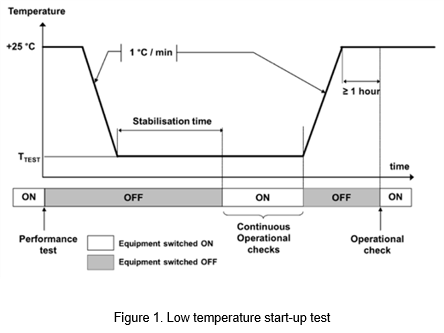
- Low temperature storage test
This test item is to verify the product's endurance in a low-temperature storage environment. It is referenced from EN 60068-2-1 (test Ab). The test conditions remain unchanged in this revision. The test method is to stay at a low temperature of -40°C for at least 16 hours, and confirm the function after returning to normal temperature.
- Damp heat test, cyclic←→Cyclic damp heat test
This test item is to evaluate the product's ability to withstand changes in temperature and humidity in the operating environment. The test methods of the two versions in Ver. 2007 and Ver. 2017 are the same. The only difference is that this test item is an optional reliability test item in Ver. 2007. However, this test item is mandatory in Ver. 2017. Whether the test is tested or not can be negotiated between the customer and the manufacturer.
This test item refers to EN 60068-2-30 (test Db), the test process is not powered on, and the test conditions are as follows:
Temperature : 25℃ & 55℃
Cycle : 2 cycles
Time : 2 x 24 hours
The diagram of Damp heat test is as follows:
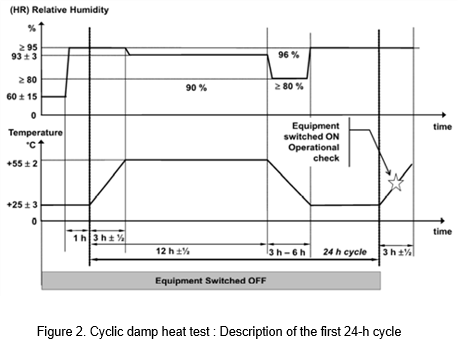
- Dry heat test
This test item is to evaluate the performance of the product under high-temperature operation in a dry heat environment. According to the different locations and equipment conditions of the product applied to railway vehicles, the temperature test conditions are selected from Table 3 above. There is only one test method for this test item in Ver. 2007, but in Ver. 2017, it can be divided into three test methods. The original test method of Ver. 2007 is equivalent to the test conditions of Cycle B in Ver. 2017. The three modes of Ver. 2017 Dry heat test must be based on the use requirements, combined with the temperature conditions in Table 3 and Table 4 above, and perform one of cycle A /B /C. The schematic diagrams of the three modes are as follows:
| Class | Switch-on extended operating temperature (duration: 10 mins) | Thermal Test Cycle |
| ST0 | No Switch-on extended operating temperature | Test Cycle A |
| ST1 | OTx+15°C | Test Cycle B |
| ST2 | OTx+15°C | Test Cycle C |
| Note 1: "OTx+15°C corresponds to (maxium temperature of "Otx" operating temperature rande of table 3)+(15°C) and only for "Otx"with "x"=1, 2, 3, 4. Note 2: Class ST1 and ST2 do not apply to classes OT5 and OT6. (unless otherwise, the requirement of class ST1 apply) | ||
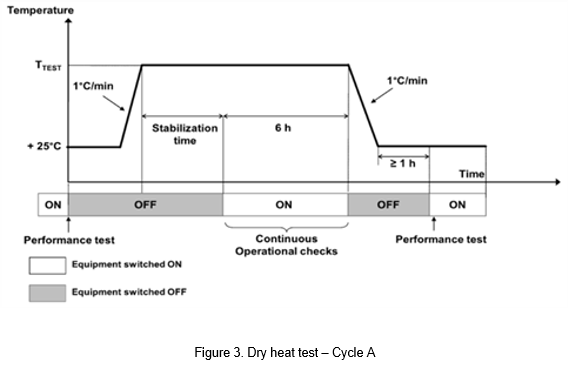
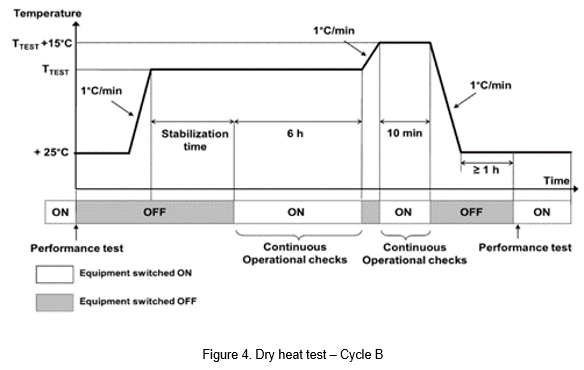
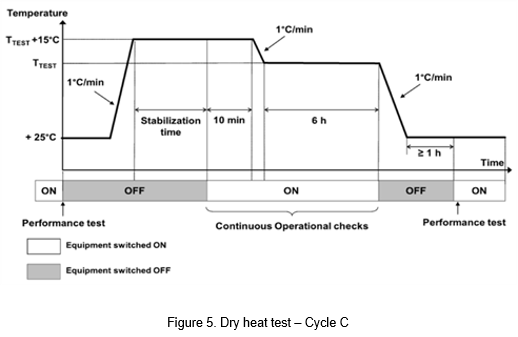
- Salt mist test
This test is used to verify the quality of the coating on the surface of the material. There is no evident difference between Ver. 2007 and Ver. 2017 in this test item. Refer to EN 60068-2-11 (test Ka), use 5% NaCl solution in a confined space at 35℃ to continuously spray the test object. Finally, confirm whether there is corrosion or defects on the surface of the material. The only difference between the two versions is that in Ver. 2017, the salt mist spraying time is 48 hours, while Ver. 2007 has 4 spraying time conditions to choose from, as follows:
Class ST1 : 4 hours
Class ST2 : 16 hours
Class ST3 : 48 hours
Class ST4 : 96 hours
- Vibration, shock and bump test←→Vibration and shock test
This test item includes vibration test and shock test. Because railway vehicles are subject to vibration and shock in the operating environment, in order to ensure that the quality of the equipment meets the requirements, it must withstand a reasonable duration test. This test simulates the operating condition in entire expected service life. There is no difference in the test methods between Ver. 2007 and Ver. 2017, and both are based on EN 61373.
The vibration test has different vibration conditions according to the product application in different parts of the car body, but they are all random vibrations, which are divided into Functional random vibration and Long-life random vibration. Functional random vibration is mainly used to verify the operation ability rather than the performance, and is only used to prove that the equipment can be used normally. Long-life random vibration is to verify the product's resistance to vibration through a longer period of time and more severe vibration conditions, but there is no need to power on during the test. The conditions of the two random vibrations are as follows in Table 5 and Table 6:


In this specification, the impact test uses a half-sine wave waveform for impact. Depending on where it is installed on the car body, there will be different impact acceleration and action time, as shown in Table 7 below:

- Rapid Temperature variation test
This test item is a new environmental reliability test item in Ver. 2017. It is mainly used to simulate the rapid temperature changes that may occur due to the influence of the environment when the train is running. There is no clear definition which regarding the experimental method of this test item in the specification, but the experimental conditions can be discussed together between the customer and the manufacturer, which is an optional test item.
Summary
EN 50155 applies to all electronic equipment such as installation, control, regulation, protection and power supply on rail vehicles. For the basic hardware and software requirements of qualified and reliable electronic equipment, many test items have been established in the specification. EN50155 also provide a concrete reference basis for pursuing the product quality and safety between suppliers and users. The reliability measurement items which suffer environmental impact are roughly the same. Because rail vehicles are subject to environmental temperature changes during running, a new reliability test item called "Rapid Temperature variation test" is added to Ver. 2017. In addition, there are also clearer definitions and illustrations of the test conditions in the Ver. 2017, so that the tester can perform the experiment more clearly.
CTC is a professional service provider for high-end power supply modules (AC to DC Converter and DC to DC Converter) for critical applications worldwide since 30 years. Our core competence is to design and deliver products with leading technologies, competitive pricing, extremely flexible lead-time, global technical service and high-quality manufacturing (Made In Taiwan).
CTC is the only corporation certificated with ISO-9001, IATF-16949, ISO22613(IRIS), and ESD/ANSI-2020. We can 100% ensure not only the product, but also our workflow and service to match quality management system for every high-end application from the very beginning. From design to manufacturing and technical support, every single detail is operated under highest standard.

